
Ago . 17, 2024 00:20 Back to list
Nasal Myiasis Treatment Options and Supplier Information for Effective Management
Nasal Myiasis Understanding the Condition and Its Treatment
Nasal myiasis is a parasitic infestation that involves the invasion of the nasal passages by larval forms of certain fly species, most commonly those from the families Calliphoridae and Sarcophagidae. While this condition is particularly rare in humans, instances have been documented, particularly in individuals with compromised immune systems or poor hygiene. This article aims to shed light on nasal myiasis, its causes, symptoms, diagnosis, and treatment options.
Causes of Nasal Myiasis
Nasal myiasis can occur when flies lay their eggs in or around the nasal area. The larvae hatch and begin to feed on the tissue, which can lead to significant discomfort and complications. High-risk groups for this condition include patients with chronic illnesses, the elderly, infants, and the disabled. Factors such as living in unsanitary environments or having open wounds can increase the likelihood of infestation.
Symptoms of Nasal Myiasis
The symptoms of nasal myiasis can vary depending on the severity of the infestation
. Common signs include1. Nasal Discomfort Individuals may experience itching, irritation, or a sensation of something moving within the nasal cavity. 2. Nasal Congestion The presence of larvae can obstruct airflow, leading to difficulty breathing through the nose. 3. Foul Odor An unpleasant smell may emanate from the nasal passages due to tissue necrosis and the presence of larvae. 4. Nasal Discharge Patients may notice purulent or blood-tinged discharge coming from the nostrils. 5. Facial Swelling In severe cases, edema or swelling may occur around the nasal area and face.
nasal myiasis supplier

Diagnosis
Diagnosing nasal myiasis typically involves a thorough clinical examination and the history of symptoms. Healthcare providers may use fiber-optic endoscopy to visualize the nasal cavities and confirm the presence of larvae. Additionally, laboratory tests may be performed to identify the specific type of fly larvae involved, assisting in tailoring the treatment approach.
Treatment Options
Treatment for nasal myiasis varies based on the extent of the infestation. Key therapeutic interventions include
1. Manual Removal In many cases, healthcare providers can manually extract the larvae from the nasal passages using specialized tools. This procedure is often performed in a clinical setting and may require local anesthesia to minimize discomfort. 2. Topical Antimicrobials After the removal of the larvae, patients may be prescribed topical antibiotics to prevent secondary infections, as the tissue may be compromised. 3. Surgical Intervention In more severe cases where the larvae have caused extensive damage or formed abscesses, surgical intervention may be necessary to remove necrotic tissue and promote healing. 4. Preventive Measures Education on hygiene, proper wound care, and pest control can help reduce the risk of nasal myiasis and other parasitic infestations.
Conclusion
Nasal myiasis is a rare but potentially serious condition that can arise from fly infestations. Understanding the causes, symptoms, and treatment strategies is essential for early diagnosis and effective management. Maintaining good hygiene and being aware of the risk factors can go a long way in preventing this unpleasant condition. For anyone experiencing nasal discomfort accompanied by unusual symptoms, seeking prompt medical attention is crucial to safeguard against complications associated with nasal myiasis.
-
China Salivation AI with GPT-4 Turbo Features
NewsAug.01,2025
-
Epic Sepsis Factories: AI-Driven Detection with GPT-4 Turbo
NewsJul.31,2025
-
Acute Salpingitis and Oophoritis AI Factory
NewsJul.31,2025
-
Premium China Bacillus Subtilis Supplier & Factory Solutions
NewsJul.30,2025
-
Premium Avermectin Supplier in China | Custom Solutions Available
NewsJul.29,2025
-
China Bacillus Subtilis Supplier - Custom Factory Solutions
NewsJul.29,2025




